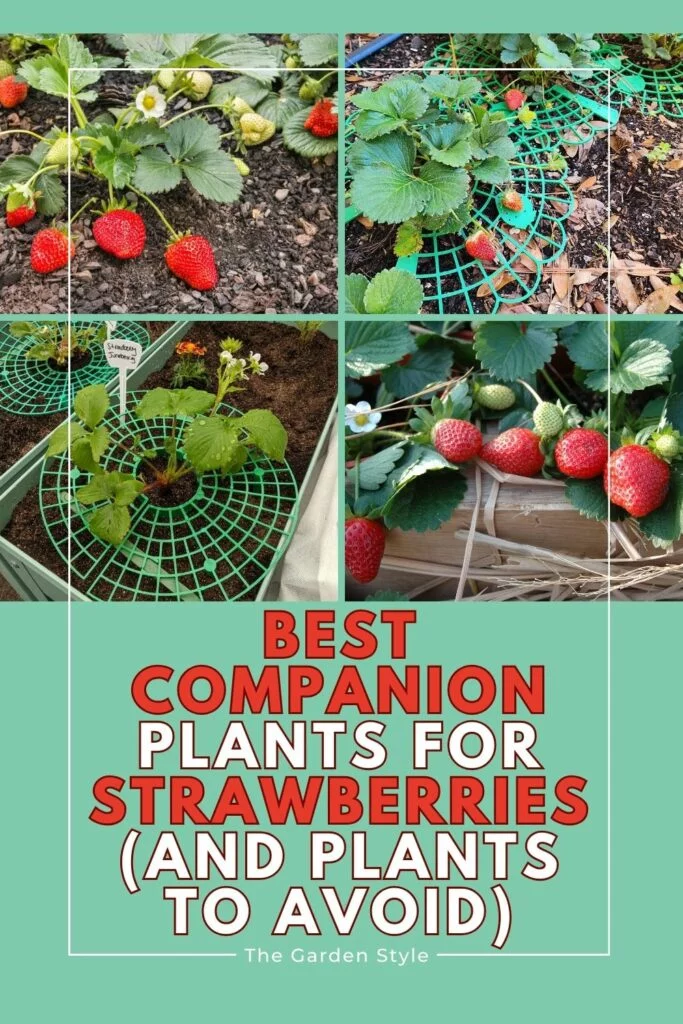If you’re a strawberry lover, you know the joy of biting into a plump, ruby-red berry bursting with sweetness. But did you know that strategically planting the best companion plants for strawberries can amplify their growth, flavor, and yield? It’s true! Companion planting is an age-old gardening practice that harnesses the power of plant synergy, and it’s about to become your strawberry patch’s new best friend.
Table of Contents
Why Companion Planting Matters for Strawberries?
Companion planting is the careful selection and arrangement of plants that can benefit one another when grown in close proximity. For strawberries, this means choosing companions that can enhance their growth, deter pests, improve soil nutrients, or provide other advantages. By fostering a harmonious garden ecosystem, you’ll not only enjoy a more bountiful strawberry harvest but also contribute to the overall health and vitality of your garden.
The Best Companion Plants for Strawberries
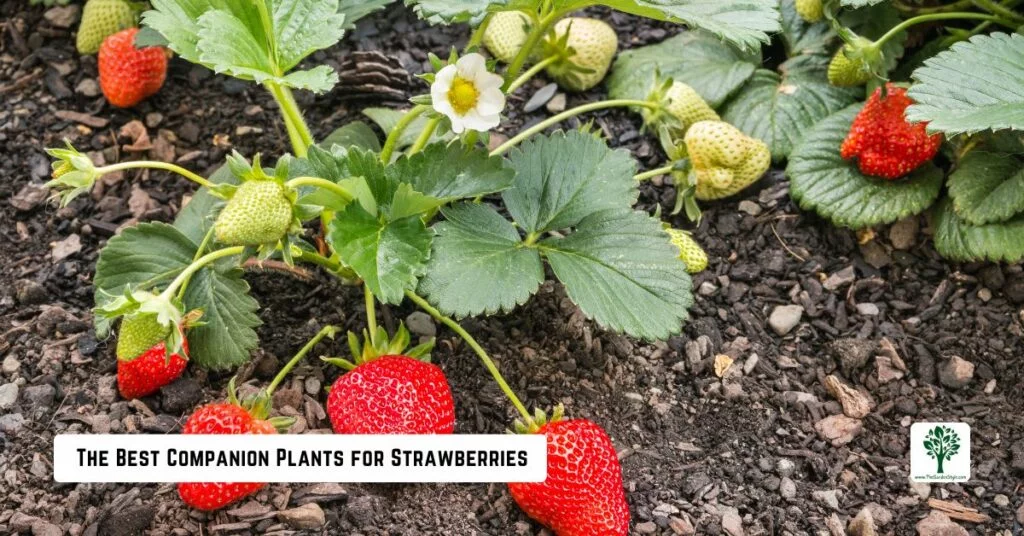
Strawberries are the queens of the fruit kingdom, but even royalty needs a little help from their friends. By carefully selecting the right plant pals, you can create a strawberry patch that’s the envy of the neighborhood. From herbs that ward off pests to flowers that beckon beneficial insects, these companions will have your strawberries thriving like never before. So, let’s dive into the star-studded cast of companions that will turn your strawberry game up a notch!
Herbs That Love Strawberries
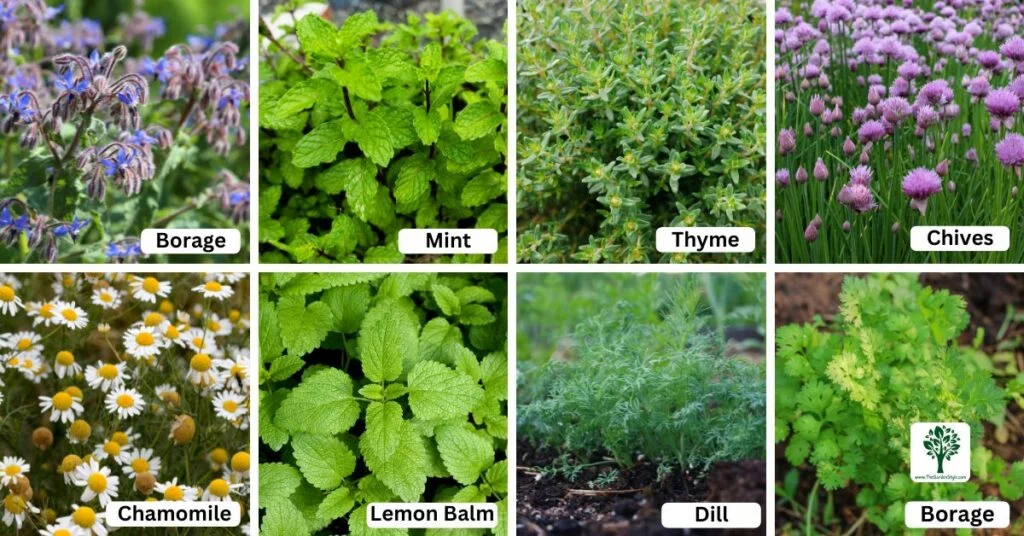
Herbs make excellent companions for strawberries, offering a range of benefits from pest control to improved flavor. Here are some top herb choices:
- Borage: Borage, known for attracting beneficial insects like bees and repelling tomato worms and cabbage moths, proves to be a true ally to strawberries. Its pretty blue flowers also add a touch of beauty to your garden.
- Mint: While it can be an aggressive spreader, mint helps deter aphids, flea beetles, and other strawberry pests with its strong aroma. Plant it in a contained area near your strawberry patch.
- Thyme: This hardy herb releases a scent that confuses many pests, making it harder for them to find your strawberries. It’s also drought-tolerant and requires little maintenance.
- Chives: These allium cousins can improve soil quality and flavor while repelling aphids and other unwanted critters with their pungent scent.
- Chamomile: The strong scent of chamomile can deter aphids, potato beetles, and other pests from your strawberry patch while also attracting beneficial insects like hoverflies and lacewings.
- Lemon Balm: This member of the mint family has a citrusy aroma that deters mosquitoes and other pests, while its small white flowers attract pollinators like bees and butterflies.
- Dill: Not only does dill attract beneficial insects like ladybugs and lacewings, but its tall stalks can also provide some light shade for strawberry plants during the hottest parts of the day.
- Cilantro: While it may seem like an unusual companion, cilantro’s strong scent can confuse and deter pests like spider mites and potato beetles from finding your strawberries.
With this diverse array of herb companions, your strawberry patch will enjoy improved pest control, pollination, and even enhanced flavors from the aromatic plant partners.
Flowering Friends for Strawberries
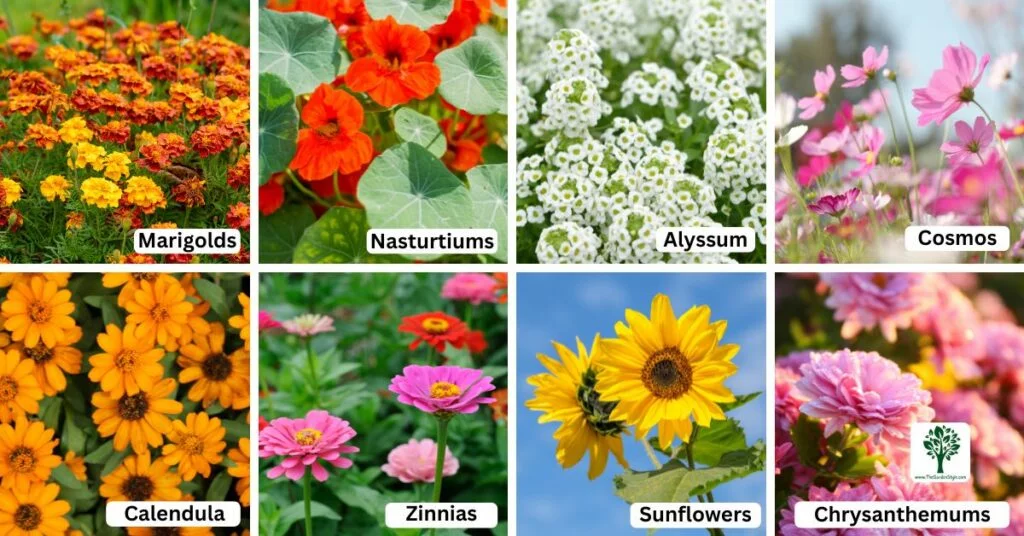
Certain flowering plants can attract beneficial insects like pollinators and predatory wasps, which can improve strawberry yields and keep pests at bay. Consider these bloomers:
- Marigolds: These sunny flowers emit a strong scent that deters nematodes, rabbits, and other pests. They also attract ladybugs, which feast on aphids.
- Nasturtiums: With their bright, edible flowers, nasturtiums can lure aphids away from your strawberries and attract predators that control those pests.
- Alyssum: This low-growing, sweetly scented flower is a magnet for beneficial insects like lacewings and parasitic wasps, which prey on strawberry pests.
- Cosmos: The vibrant blooms of cosmos flowers are irresistible to pollinators like bees and butterflies, ensuring a good fruit set for your strawberries. They also help repel nematodes and other soil-dwelling pests.
- Calendula: Also known as pot marigold, calendula’s strong scent confuses pests like aphids and spider mites, while its sunny blooms attract ladybugs and other beneficial predators.
- Zinnias: These cheerful, long-blooming flowers are excellent for attracting pollinators and beneficial insects to your strawberry patch. They also help deter ants, cucumber beetles, and other unwanted visitors.
- Sunflowers: While they can get quite tall, sunflowers make great companions for strawberries by attracting pollinators and providing light shade during the hottest parts of the day.
- Chrysanthemums: These hardy, long-lasting blooms can help control nematodes, root weevils, and other soil-dwelling pests that could harm your strawberry plants.
With this vibrant array of flowering companions, your strawberry patch will not only look beautiful but also benefit from improved pollination, pest control, and overall plant health.
Vegetables that Coexist Happily with Strawberries
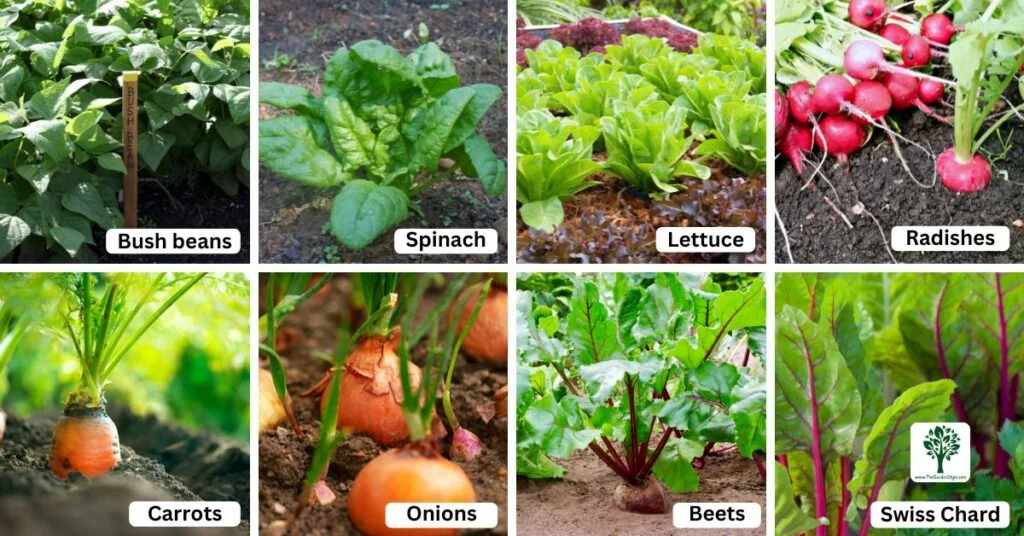
Who says veggies can’t be strawberry companions? These versatile plants can provide nutrients, shade, or pest protection for your beloved berries:
- Bush beans: As legumes, bush beans can fix nitrogen in the soil, providing a nutrient boost for strawberries. They also offer light shade, which strawberries appreciate.
- Spinach: This cool-season crop can act as a living mulch, suppressing weeds and retaining moisture for your strawberries during the warmer months.
- Lettuce: Like spinach, lettuce can serve as a living mulch and provide some shade for strawberry plants while taking up minimal space.
- Radishes: These rapid-growing veggies can act as a trap crop, luring pests like root maggots away from your strawberries. They’re also a great partner for crop rotation.
- Carrots: The feathery tops of carrot plants can provide light shade and moisture retention for strawberries while their roots loosen the soil for better drainage.
- Onions: With their pungent aroma, onions can help repel aphids, thrips, and other pests that might bother your strawberry plants. They’re also a good companion for crop rotation.
- Beets: These nutrient-rich veggies can help loosen and aerate the soil around strawberries with their deep taproots, improving drainage and nutrient uptake.
- Swiss Chard: This leafy green can double as a living mulch, retaining moisture and shading the soil around your strawberry plants during hot weather.
With this diverse array of vegetable companions, your strawberry patch will benefit from improved soil quality, pest control, and even some bonus harvests alongside your sweet berries!
Best Companion Plants for Strawberries Chart
| Plant | Type | Benefits for Strawberries |
| Borage | Herb | Attracts pollinators, repels pests like tomato worms and cabbage moths |
| Mint | Herb | Deters aphids, flea beetles, and other pests with its strong aroma |
| Thyme | Herb | Releases scent that confuses pests, drought-tolerant |
| Chives | Herb | Improves soil quality, repels aphids and other pests |
| Chamomile | Herb | Deters aphids, potato beetles, and attracts beneficial insects |
| Lemon Balm | Herb | It deters mosquitoes, attracts pollinators like bees and butterflies |
| Dill | Herb | It attracts ladybugs, lacewings, and provides light shade |
| Cilantro | Herb | Confuses and deters pests like spider mites and potato beetles |
| Marigolds | Flower | Deters nematodes, rabbits, and attracts ladybugs |
| Nasturtiums | Flower | Lures aphids away, attracts predators that control aphids |
| Alyssum | Flower | Attracts lacewings, parasitic wasps that prey on strawberry pests |
| Cosmos | Flower | Attracts pollinators, repels nematodes and soil pests |
| Calendula | Flower | Confuses aphids, spider mites, and attracts ladybugs |
| Zinnias | Flower | Attracts pollinators, deters ants, cucumber beetles |
| Sunflowers | Flower | Attracts pollinators, provides light shade |
| Chrysanthemums | Flower | Controls nematodes, root weevils, and other soil pests |
| Bush Beans | Vegetable | It fixes nitrogen in the soil, provides light shade |
| Spinach | Vegetable | Acts as a living mulch, suppresses weeds, retains moisture |
| Lettuce | Vegetable | Living mulch, provides some shade |
| Radishes | Vegetable | Trap crop for root maggots, good for crop rotation |
| Carrots | Vegetable | Tops provide light shade, moisture retention, roots loosen soil |
| Onions | Vegetable | Repels aphids, thrips with pungent aroma, good for crop rotation |
| Beets | Vegetable | Taproots loosen soil, improve drainage and nutrient uptake |
| Swiss Chard | Vegetable | Living mulch, retains moisture, and shades soil in hot weather |
Plants to Avoid Near Strawberries
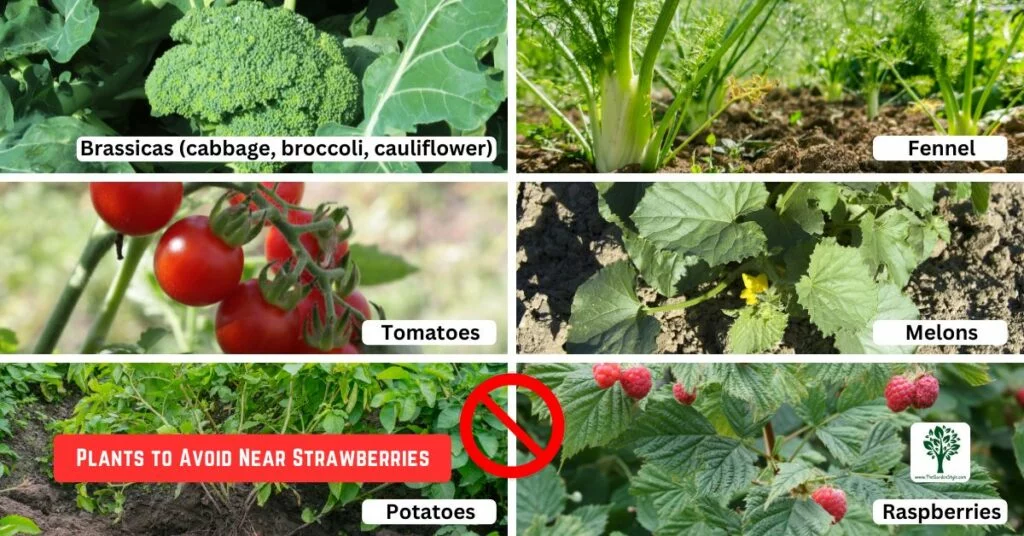
While many plants make great strawberry companions, others can compete for resources or harbor pests and diseases that could harm your berries. Here are some plants to keep separate from your strawberry patch.
- Brassicas (cabbage, broccoli, cauliflower): These nutrient-hungry crops can deplete the soil of nutrients that strawberries need, stunting their growth.
- Tomatoes: While tasty in a salad, tomatoes and strawberries don’t mix well in the garden. Tomatoes can harbor verticillium wilt, a fungal disease that can spread to strawberries.
- Potatoes: Like tomatoes, potatoes can carry verticillium wilt, making them a poor choice for planting near strawberries.
- Fennel: This aromatic herb can inhibit strawberry growth and flavor due to its allelopathic properties.
- Melons: Sprawling melon vines can crowd out and shade strawberry plants, affecting their growth and yield.
- Raspberries: While both are berries, raspberries and strawberries shouldn’t be planted together, as they can spread viruses and diseases to one another.
Designing Your Strawberry Companion Garden
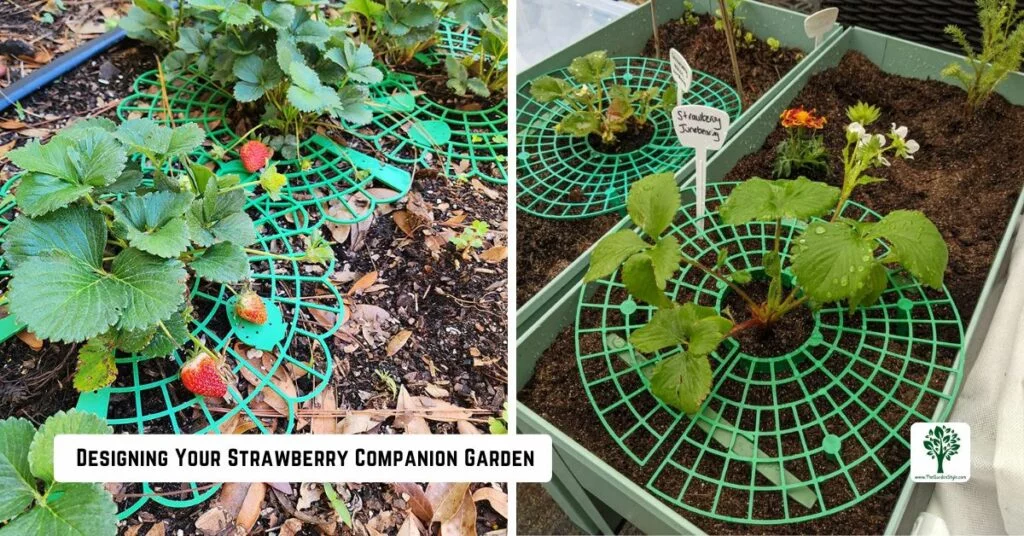
Now that you know the best and worst plant pairings for strawberries, it’s time to design your companion garden. Here are some tips:
- Arrange taller plants like bush beans or flowering companions on the north side of your strawberry patch to avoid excessive shading.
- Leave enough space between plants to allow for air circulation and easy harvesting.
- Group plants with similar water and sunlight needs together for efficient care.
- Rotate your strawberry patch to a new location every 3-4 years to avoid soil depletion and pest buildup.
In addition to using the appropriate companion plants for strawberries, it is very important to use support. These supports help keep the fruits clean at all times and also reduce certain risks of pests and diseases.
With a little planning and the right plant partners, your strawberry patch will thrive and reward you with a bounty of sweet, juicy berries year after year.
Recommended reading: How to Get Rid of Ants on Strawberry Plants – 7 Ways
- Every Pack including 2 rails, 4 stakes and connecting rod that make up a complete strawberry stand.
- Easy to assemble, fit the support around your existing plants, snap together two ends, lock buttons and gently insert legs of the support into the ground.
Final Conclusions
By embracing the art of companion planting, you can unlock a world of bountiful strawberry harvests and a thriving, balanced garden ecosystem. From herbs and flowers to vegetables, the best companion plants for strawberries can enhance.
Recommended reading: How to Grow Strawberries in a Pot
Frequently Asked Questions
Companion planting for strawberries can improve soil quality, deter pests, attract beneficial insects, provide shade or living mulch, and ultimately increase strawberry yields and flavor.
Consider the specific needs of strawberries, such as soil nutrients, pest deterrents, and partial shade. Choose companions that offer complementary benefits without competing for resources.
It’s best to avoid planting strawberries with other fruit crops like raspberries or melons, as they can share diseases and pests or compete for resources.
Spacing will depend on the specific plants involved. Still, generally, the aim is to reach at least 6-12 inches between strawberry plants and their companions to allow for air circulation and growth.
If this post about the best companion plants for strawberries was helpful, please share it:
